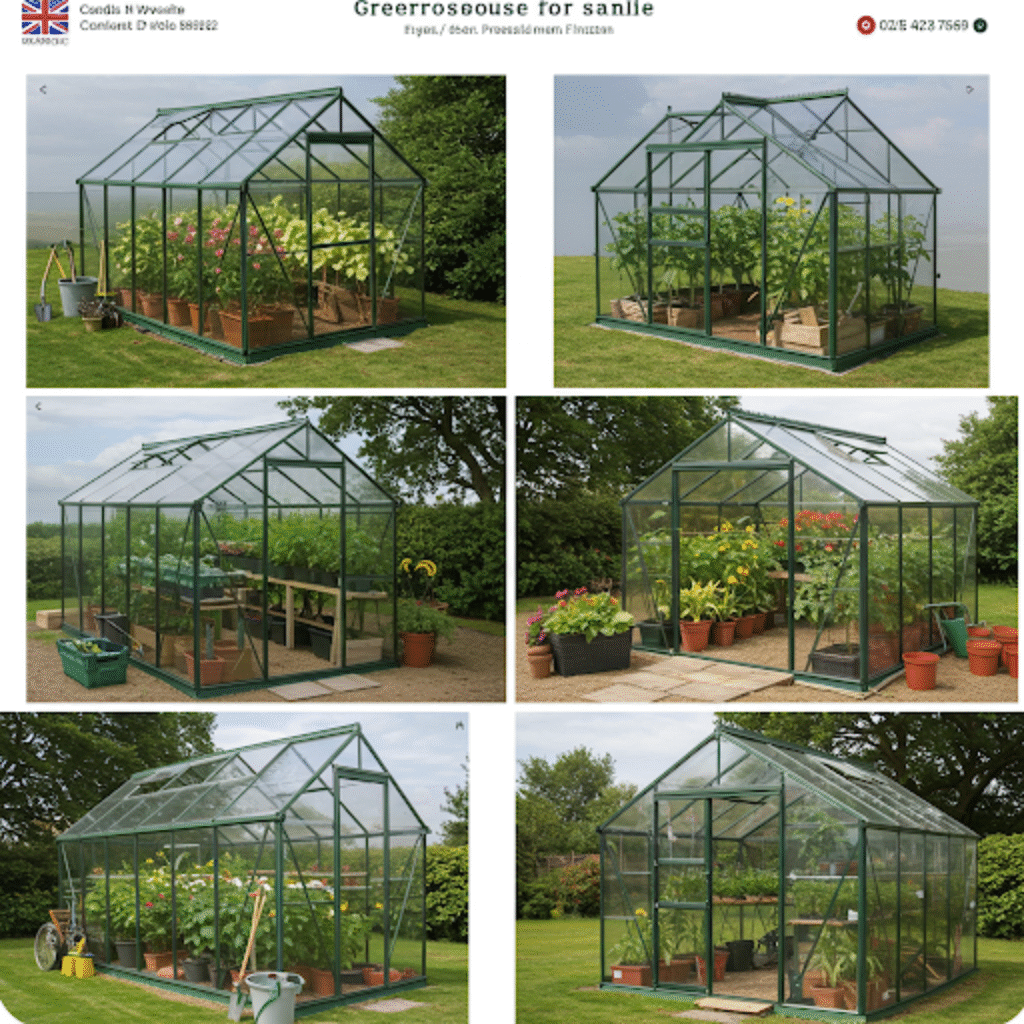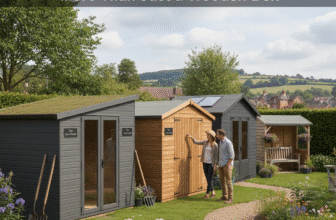
Unlock Year-Round Gardening Joy: Finding the Perfect Greenhouse for Sale in the UK
There’s a certain magic to stepping inside a greenhouse, isn’t there? That gentle warmth, the earthy smell of damp soil, the vibrant green of plants thriving regardless of the weather outside – it’s a gardener’s sanctuary. For many in the UK, with our famously unpredictable climate, a greenhouse isn’t just a luxury; it’s a gateway to extending the growing season, experimenting with exotic plants, and achieving truly impressive harvests. If you’ve been dreaming of tomatoes ripening on the vine in October or nurturing delicate seedlings safe from frost, exploring the world of greenhouses for sale could be the start of a wonderful gardening adventure.
Owning a greenhouse transforms your gardening capabilities. It’s more than just a structure; it’s a controlled environment where you become the master of conditions, shielding your precious plants from harsh winds, torrential rain, sudden frosts, and even common pests. It allows you to start seeds earlier in spring, continue harvesting later into autumn, and even overwinter tender perennials that wouldn’t survive an exposed British winter. It opens up possibilities for growing crops that typically struggle outdoors in cooler regions, like peppers, aubergines, melons, and cucumbers. Essentially, it puts you firmly in the driver’s seat of your gardening year.
Why Embrace Greenhouse Gardening in the UK?
The British weather is, to put it mildly, changeable. One day might bring glorious sunshine, the next horizontal rain or even a late spring frost. This variability can be frustrating for gardeners trying to nurture plants to maturity. A greenhouse acts as a buffer, creating a microclimate that offers several key advantages:

- Extended Growing Season: This is perhaps the most significant benefit. Start sowing seeds weeks, even months, earlier than you could outdoors. Protect young plants from the cold and continue growing well into autumn and winter, depending on the crops and any heating used.
- Weather Protection: Your plants are shielded from the damaging effects of strong winds, heavy rain, hail, and frost. Delicate seedlings and ripening fruits are kept safe and sound.
- Pest and Disease Control: While not entirely immune, a greenhouse provides a physical barrier against many common garden pests like slugs, snails, rabbits, and pigeons. It can also help manage airborne fungal diseases by controlling humidity and airflow.
- Growing Tender and Exotic Plants: Fancy growing chillies, citrus trees, or perhaps even orchids? A greenhouse provides the consistent warmth and humidity many of these plants crave, making the impossible possible for UK gardeners.
- Better Germination and Propagation: The stable, warm, and humid environment inside a greenhouse is ideal for seed germination and taking cuttings, significantly increasing your success rate.
- Consistent Results: By controlling the environment – temperature, watering, humidity – you can achieve more predictable and often more abundant harvests compared to outdoor growing.
Navigating the Options: Types of Greenhouses for Sale
When you start looking at greenhouses for sale, you’ll quickly realise there’s a vast array of options. Understanding the different materials and styles is crucial to finding the one that best suits your needs, budget, and garden aesthetic.
Frame Materials: The Backbone of Your Greenhouse
- Aluminium: By far the most popular choice in the UK, and for good reason. Aluminium frames are lightweight, strong, resistant to rust and rot, and require virtually no maintenance beyond occasional cleaning. They often come in a natural silver finish or powder-coated options (green is very common, blending well with garden surroundings, but black and other colours are available). They conduct heat relatively well, meaning they warm up and cool down quickly.
- Wood: Timber-framed greenhouses offer a traditional, aesthetically pleasing look that many gardeners adore. Wood is a natural insulator, helping to maintain a more stable temperature compared to aluminium. However, wooden frames require regular maintenance – treating or painting every few years – to prevent rot and warping, especially in the damp UK climate. Cedar is a popular choice due to its natural resistance to decay, but it often comes at a higher price point.
- Steel: Less common for domestic greenhouses but sometimes used for larger or more robust structures. Steel offers great strength but needs to be properly galvanised or treated to prevent rust.
Glazing Materials: Letting the Light In
The ‘glass’ of your greenhouse is critical for light transmission and insulation.
- Horticultural Glass: The traditional choice. It offers excellent light clarity, doesn’t degrade or discolour over time, and is relatively inexpensive. The main downside is that it breaks easily into sharp shards, which can be a safety concern, especially if children or pets are around. Standard panes are typically 3mm thick.
- Toughened Safety Glass: This glass undergoes a special heating and cooling process, making it significantly stronger (around 4-5 times) than horticultural glass. If it does break, it shatters into small, relatively harmless granular pieces, much like a car windscreen. It offers the same clarity as horticultural glass but comes at a higher cost. Often supplied in larger, full-length panes, enhancing the aesthetic.
- Polycarbonate: A type of plastic glazing that’s becoming increasingly popular. It’s virtually unbreakable, making it the safest option. Twin-wall polycarbonate, with its double-layered structure and air gap in between, offers much better insulation than glass, helping to retain heat and potentially reducing heating costs. It diffuses light rather than transmitting it directly, which can prevent scorching on very sunny days. However, it can be prone to scratching, may slightly discolour over time (though UV-protected versions mitigate this), and can sometimes harbour algae within the channels if not sealed properly. Available in various thicknesses (e.g., 4mm, 6mm, 8mm), with thicker options providing better insulation.
Shapes and Styles: Finding the Right Fit
- Traditional Apex Roof: The classic greenhouse shape with a pointed roof. Excellent for shedding rainwater and snow, and provides good headroom along the central ridge. Available in countless sizes.
- Lean-to: Designed to be built against an existing wall (house, garage, garden wall). They benefit from the heat radiated by the wall, making them naturally warmer. Ideal for smaller gardens or courtyards, saving space and often requiring less material. Ensure the wall chosen receives adequate sunlight.
- Octagonal or Hexagonal: Attractive, feature greenhouses that can become a focal point in the garden. Offer good light exposure from multiple angles but can sometimes have less usable growing space compared to rectangular designs of a similar footprint due to their shape.
- Geodesic Domes: Less common but very strong and wind-resistant due to their structure. Offer excellent light distribution but can be more complex to assemble and glaze.
- Cold Frames: While not full greenhouses, these low-level structures with a glazed lid are perfect for hardening off young plants or protecting low-growing crops like lettuce through winter. A good starting point if space or budget is limited.
Size Matters: How Big Should You Go?
One of the most common pieces of advice from seasoned greenhouse owners is to buy the biggest greenhouse you can afford and accommodate in your garden. It’s amazing how quickly space fills up! Consider:
- Available Space: Measure your intended site carefully, remembering to leave enough space around the greenhouse for access, cleaning, and maintenance (at least 1-2 feet).
- Gardening Ambitions: Are you just starting a few tomato plants, or do you envision rows of staging filled with seedlings, cuttings, and exotic specimens? Be realistic, but allow for growth.
- Working Room: You need space to move around, tend to plants, and potentially store tools or bags of compost inside. Ensure there’s enough headroom, especially if you’re tall.
- Budget: Larger greenhouses naturally cost more, not just initially but potentially in terms of heating if you choose to install it.
Common domestic sizes in the UK range from small 4ft x 6ft models, suitable for basic propagation and a few crops, up to larger 8ft x 10ft or 10ft x 12ft structures offering substantial growing space. Lean-to models can vary significantly in depth but are constrained by the length of the wall they attach to.
Essential Features to Consider
Beyond the basic frame and glazing, several features significantly impact a greenhouse’s usability and effectiveness.
- Ventilation: Absolutely crucial for controlling temperature and humidity, and preventing fungal diseases. Look for roof vents (essential for releasing hot air) and potentially side or louvre vents for better airflow. The more vents, the better, especially for larger greenhouses. Consider automatic vent openers – these use a wax-filled cylinder that expands in heat, automatically opening the vent without needing electricity or manual intervention. They are invaluable for maintaining a stable temperature when you’re not around.
- Doors: Sliding doors save space compared to hinged doors, which need clearance to swing open. Ensure the door provides easy access, especially if you’ll be using a wheelbarrow. Some larger models offer double doors. A low threshold or ‘drop door’ design makes access easier.
- Base/Foundation: Most greenhouses require a firm, level base. Some smaller, lighter models might include a metal base frame that can be anchored directly to soft ground, but for longevity and stability, a solid foundation of paving slabs or concrete is recommended, especially for larger structures or glass-glazed models. Ensure the base is perfectly square and level for easier assembly and proper door function.
- Shelving and Staging: Essential for maximising growing space. Staging provides waist-height working surfaces for potting and accommodates seed trays, while higher shelves are useful for smaller pots or trailing plants. Look for integrated staging options or plan to purchase/build your own. Aluminium or slatted wooden staging allows for good drainage and air circulation.
- Heating: While not essential for all uses, heating extends the growing season significantly, allowing for propagation early in the year and protecting tender plants through winter. Options range from small electric fan heaters (good for air circulation too) and paraffin heaters (produce moisture) to more sophisticated tube heaters or even soil warming cables. Consider insulation (like bubble wrap lining in winter) to make heating more efficient.
- Irrigation: Consistent watering is key. Options range from manual watering with a can or hose to automated systems like seep hoses or drip irrigation, which can be invaluable if you’re away frequently. Water butts connected to the greenhouse gutters are a sustainable way to collect rainwater.
Location, Location, Location (and Planning Permission)
Where you site your greenhouse is critical. Aim for a spot that receives maximum sunlight, ideally with the ridge running east to west to capture sun throughout the day, although a north-south orientation is also viable. Avoid areas shaded by buildings or large trees. Shelter from strong prevailing winds is beneficial, perhaps using a hedge or fence as a windbreak (but not so close that it casts excessive shade). Ensure easy access for carrying tools, compost, and water.
Regarding planning permission in the UK, most standard-sized domestic greenhouses fall under ‘permitted development’ rights, especially if positioned in a back garden and meeting certain size and height criteria (e.g., not taking up more than 50% of the garden area, specific height limits depending on proximity to boundaries). However, rules can vary, especially in conservation areas or for listed buildings. It is *always* advisable to check with your local council planning department before purchasing and installing a greenhouse to be certain.
Setting Up Your Greenhouse Haven
Once you’ve chosen your greenhouse, the next step is installation. Many greenhouses are designed for DIY assembly, coming with detailed instructions. It’s usually a two-person job and requires patience and careful following of the steps. Ensure your base is perfectly level and square before you begin.
Alternatively, many suppliers offer a professional installation service for an additional fee. This can save time and hassle, ensuring the structure is erected correctly and safely, which is particularly worthwhile for larger or more complex models, or if DIY isn’t your forte.
Making the Most of Your Investment
A greenhouse opens up a world of possibilities:
- Early Spring: Sow hardy annuals, brassicas, lettuce, radishes, and start off tender plants like tomatoes and peppers.
- Summer: Grow heat-loving crops – tomatoes, cucumbers, peppers, chillies, aubergines, melons. Propagate cuttings.
- Autumn: Harvest late crops, sow winter salads, protect tender plants before the first frosts.
- Winter: Overwinter tender perennials (fuchsias, geraniums), grow hardy salads, force bulbs, store root vegetables (if frost-free).
Experimentation is part of the fun. Learn about companion planting, crop rotation (even within the greenhouse), and managing ventilation and humidity for optimal results.
Keeping it Shipshape: Maintenance
Greenhouses require some upkeep to perform at their best:
- Cleaning: Clean the glazing inside and out at least once a year (late autumn/winter is ideal) to maximise light transmission. Use specific greenhouse cleaners or just warm soapy water.
- Checks: Regularly check seals, ensure vents and doors operate smoothly, and inspect the frame for any damage or (for wood) signs of rot.
- Pest Control: Be vigilant for common greenhouse pests like aphids, whitefly, and red spider mite. Good hygiene and ventilation help prevent issues. Biological controls or insecticidal soaps can be used if needed.
- Ventilation Management: Adjust vents according to the weather to maintain optimal temperatures and prevent overheating or excessive humidity.
Finding Greenhouses for Sale UK Wide
You can find greenhouses for sale through various channels in the UK. Large garden centres often have display models allowing you to see the quality and features first-hand. Specialist online retailers typically offer a wider range and competitive pricing, often with delivery and installation options. DIY stores also stock a selection, usually focusing on popular sizes and types. Compare prices, delivery costs, guarantees, and customer reviews before making a purchase.
Budgeting for Your Greenhouse
Prices vary enormously depending on size, frame material, glazing type, and brand. A small, basic aluminium-framed polycarbonate model might start from a few hundred pounds. A larger, cedar-framed greenhouse with toughened glass could run into several thousand pounds. Remember to factor in the cost of the base, any optional accessories (staging, heaters, auto-vents), and potential installation fees. While tempting to go for the cheapest option, view your greenhouse as a long-term investment. A well-built structure will provide many years of gardening pleasure.
Ready to Grow?
A greenhouse is more than just a garden building; it’s an investment in your passion for gardening. It offers control, extends possibilities, and provides a sanctuary where you can connect with nature, whatever the weather. By considering the types, sizes, features, and location carefully, you can find the perfect greenhouse for sale that will bring you years of productive, rewarding, and joyful gardening in your own UK haven.







